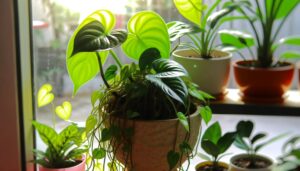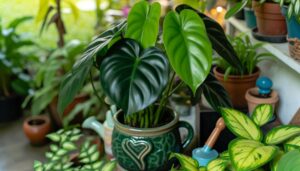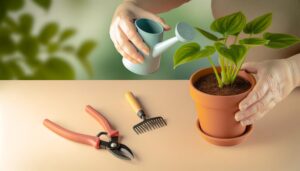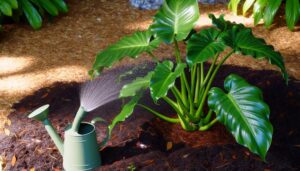How Do I Care for Philodendron Bipinnatifidum Roots? Guide!
To care for Philodendron Bipinnatifidum roots, understand their structural complexity and the importance of a healthy root system. Regular inspection enables early detection of root issues.
Root health is influenced by suitable pot size, ideal soil type, accurate watering, and cautious fertilization. Root pruning, effective disease management, and timely repotting are critical for robust plant health.
These activities maintain balance between root system and above-ground growth, supporting efficient nutrient uptake. Developing appropriate strategies for these integral aspects can make a phenomenal improvement to your plant’s health.
Further exploration will equip you with detailed insights and techniques.
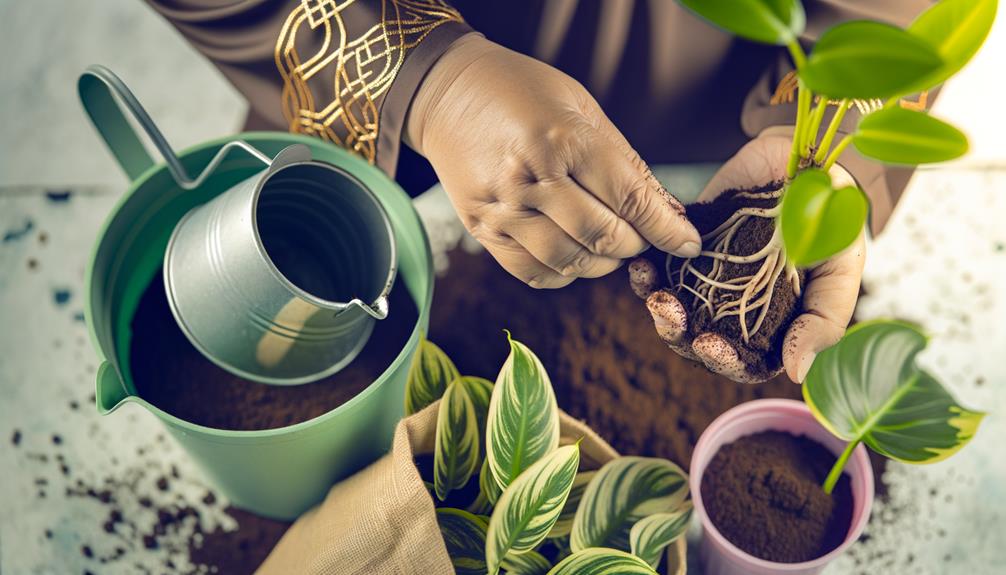
Key Takeaways
- Ensure proper pot size and soil type, favoring well-draining soil with a pH between 6.0 and 7.0 for optimal root health.
- Implement a watering schedule based on the plant’s moisture requirements to prevent root saturation or desiccation.
- Use fertilizers rich in nitrogen, phosphorus, and potassium judiciously to enhance root development and prevent damage.
- Perform root pruning to stimulate growth, removing old or damaged roots using sterilized equipment.
- Repot the Philodendron Bipinnatifidum every 2-3 years in a slightly larger pot, examining the root ball for disease or damage during the process.
Understanding Philodendron Bipinnatifidum Roots
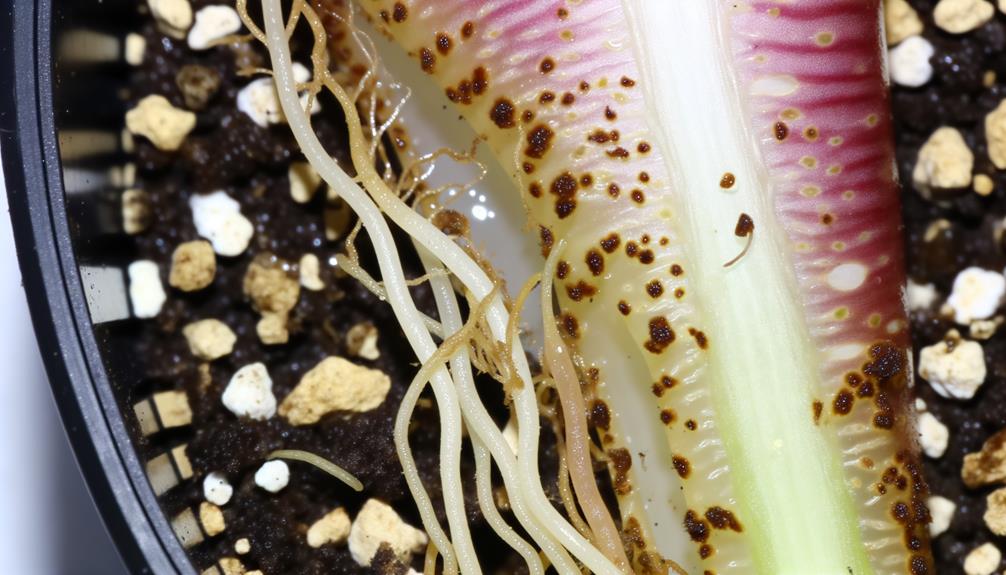
In order to provide the best care for the Philodendron Bipinnatifidum, a thorough understanding of its intricate root system is fundamentally crucial. The plant’s ability to absorb nutrients and water relies heavily on its root system. A mature Bipinnatifidum’s root system consists of both primary and secondary roots.
The primary roots serve to anchor the plant and absorb large amounts of water. On the other hand, the secondary roots, which include root hairs, are mainly responsible for nutrient uptake. The roots’ complex structure, striking a delicate balance between strength and flexibility, allows the plant to thrive in various soil conditions.
Understanding this root system, along with the mechanisms by which the roots interact with their environment, is essential for ensuring the health and longevity of the Philodendron Bipinnatifidum.
Importance of a Healthy Root System
The importance of a Philodendron Bipinnatifidum plant is inherently tied to the health of its root system. A strong root system is necessary for nutrient uptake, water absorption, and overall plant stability.
Thereby, understanding root system essentials and strategies for root damage prevention is essential for maintaining plant vigor and longevity.
Root System Essentials
Understanding the importance of a strong root system is crucial for the successful growth and development of the Philodendron Bipinnatifidum. A robust root system plays a key role in the plant’s capacity to absorb essential nutrients and water from the soil, firmly securing it in place, and providing the necessary support for growth.
The complex network of primary, secondary, and tertiary roots, each with their specific functions, constitutes the plant’s life-sustaining system. Primary roots penetrate deeply into the soil to anchor the plant, secondary roots enhance surface area for nutrient absorption, and tertiary roots assist in water uptake.
Ensuring these roots are healthy and functioning at their best necessitates in-depth knowledge, attentive observation, and tailored care strategies. Consequently, the health of a Philodendron Bipinnatifidum is closely linked to the well-being of its root system.
Root Damage Prevention
Protecting the Philodendron Bipinnatifidum against root damage is an essential aspect of maintaining a healthy root system. This directly impacts the plant’s overall growth, survival, and ability to effectively absorb nutrients and water.
Any disruption in the root structure compromises the plant’s health, leading to stunted growth and reduced energy. As a result, preventative measures are indispensable. These include appropriate watering, avoiding overly compact soil, and regular inspections for root pests.
Careful handling during repotting is also crucial to prevent mechanical injuries. Utilizing soil rich in organic matter can enhance root resilience, promote healthy growth, and provide a buffer against potential harm.
Hence, understanding and implementing damage prevention strategies can significantly contribute to the longevity and prosperity of the Philodendron Bipinnatifidum.
Identifying Root Problems
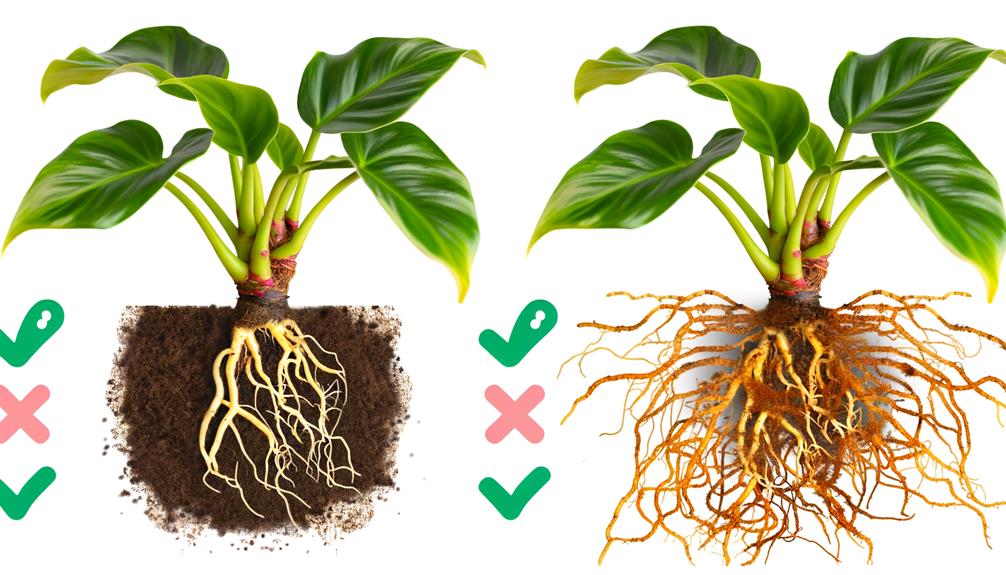
In the world of Philodendron Bipinnatifidum care, early detection of root problems can greatly improve the health and longevity of the plant. To identify potential issues, closely inspect the roots for signs of rot, which often manifests as black, mushy roots with a foul smell. This is usually due to overwatering and poor drainage, leading to a waterlogged environment conducive to bacterial and fungal growth.
Another common problem is root burn resulting from excessive fertilizer use. Symptoms include brown, shriveled roots and stunted growth.
Choosing the Right Pot Size
The selection of an appropriate pot size is essential to the healthy development of Philodendron Bipinnatifidum roots.
This vital decision is influenced by several factors, including:
- The understanding of pot size importance.
- Determining suitable pot dimensions.
- Circumventing the problems posed by oversized pots.
A thorough examination of these points will provide a detailed guide to pot selection, facilitating ideal root growth and overall plant health.
Understanding Pot Size Importance
An essential aspect of successful Philodendron Bipinnatifidum root care involves careful selection of the appropriate pot size, a seemingly ordinary decision that has a significant impact on the plant’s overall health and growth. This choice influences the plant’s root development, water retention, and nutrient absorption.
Consider the following table:
| Pot Size | Plant Impact |
|---|---|
| Too Small | Limits root growth, may cause root-bound condition |
| Ideal | Allows sufficient root growth, proper water and nutrient absorption |
| Too Large | May hold excess water, leading to root rot |
A pot too small restricts root expansion, impeding growth. The ideal pot size promotes healthy root development and ensures effective nutrient uptake. Conversely, a pot too large can hold excess water, potentially causing root rot. Understanding pot size importance is vital in meeting the needs of your Philodendron Bipinnatifidum.
Selecting Suitable Pot Dimensions
Proper pot dimension selection is essential for ideal Philodendron Bipinnatifidum root health. This requires careful analysis and understanding of the plant’s growth patterns and nutritional needs. Best pot size should comfortably accommodate the growth of the plant’s root system, while providing ample space for the diffusion of nutrients and water.
For young Philodendron Bipinnatifidum, a pot with a 10-12 inch diameter is generally sufficient. As the plant grows, it may require repotting into a larger container, usually about two inches larger in diameter. However, avoid excessively large pots as they may retain excessive moisture, leading to root rot.
The pot’s depth should also be considered. Deeper pots facilitate better root expansion, thereby enhancing the plant’s overall growth and stability.
Overcoming Oversized Pot Issues
Remarkably, a common mistake in Philodendron Bipinnatifidum care is the overestimation of the necessary pot size, which can lead to detrimental issues such as root rot due to waterlogged soil.
To avoid this, one must consider the root-ball size and plant’s growth rate when selecting a pot. A container too large allows the soil to remain damp for prolonged periods, creating a conducive environment for roots’ fungal infections. Conversely, an adequately sized pot will balance moisture retention and drainage, fostering healthy root development.
For young plants, choose a pot no more than 2-3 inches wider than the root-ball. As the plant matures, incrementally increase the pot size. This meticulous approach ensures optimal root health, leading to a thriving Philodendron Bipinnatifidum.
Selecting the Ideal Soil Type
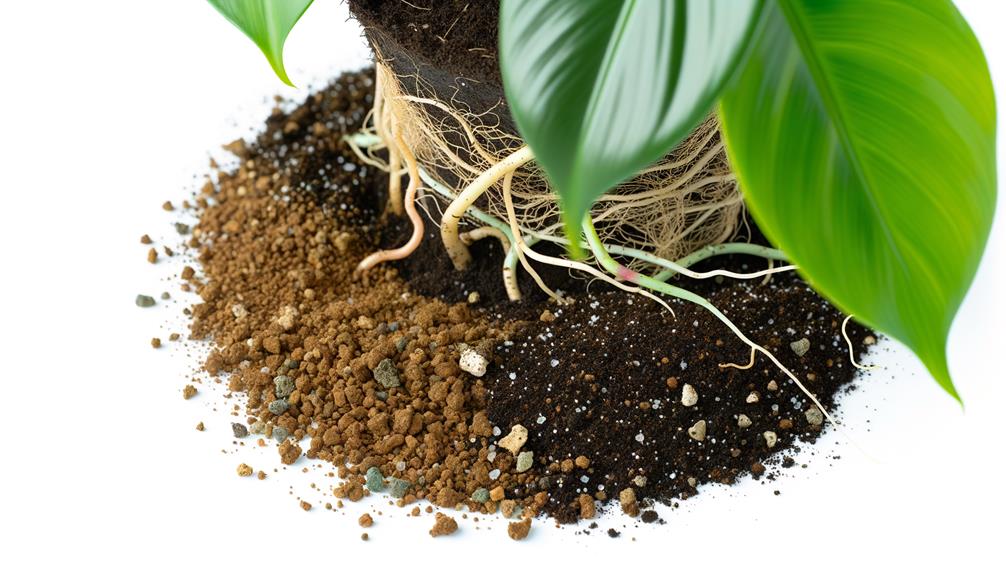
The process of selecting the perfect soil type for Philodendron Bipinnatifidum is crucial in ensuring the best root health and overall plant strength. Choosing an ideal soil type involves a careful balance of factors that promote aeration, root expansion, and nutrient absorption.
This plant thrives most in well-draining soil that is rich in organic matter. A mix of peat moss, perlite, and compost, in equal proportions, provides the right texture, ensuring optimal root aeration and moisture retention. Additionally, the soil pH should be between 6.0 and 7.0, facilitating nutrient availability in the root zone.
This soil composition creates a favorable environment for root growth, fostering a robust Philodendron Bipinnatifidum, capable of withstanding various stressors.
Correct Watering Techniques for Roots
Highlighting the importance of hydration for Philodendron Bipinnatifidum, it is crucial to use proper watering techniques that promote ideal root health without inducing waterlogging or root rot. A systematic approach to watering involves determining the plant’s moisture requirements, then creating a schedule that caters to these needs.
Precise intervals between watering, depending on environmental factors such as humidity and temperature, guarantee the roots aren’t overly saturated or desiccated. Adequate drainage is essential, reducing the risk of water stagnation and subsequent root diseases.
Ideally, water thoroughly until excess moisture seeps from drainage holes, then allow soil to dry before the next watering. This cyclical process mimics the plant’s natural rainforest habitat, fostering strong root systems and overall plant health.
Role of Fertilizer in Root Health
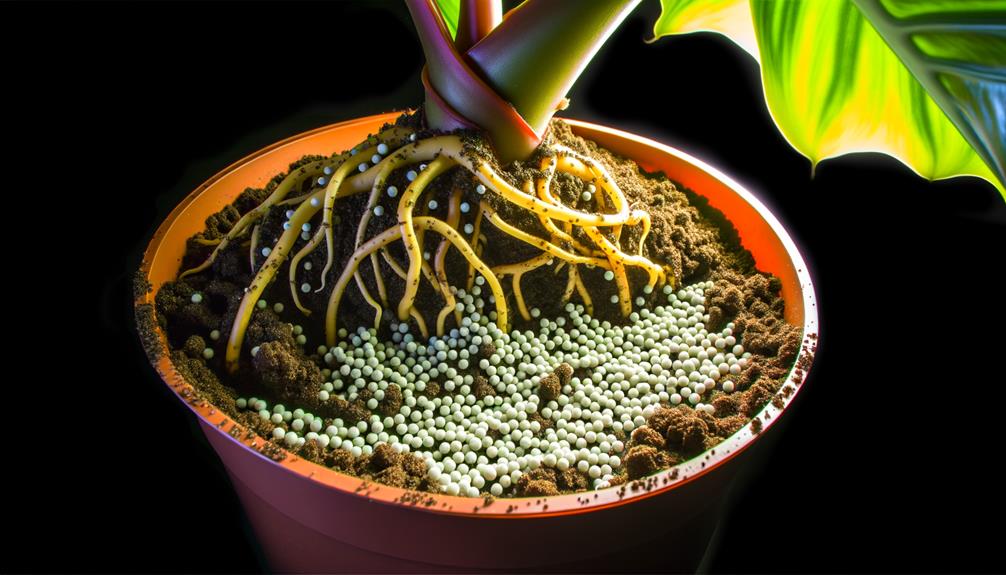
Nourishment from carefully selected fertilizers plays a vital role in supporting the robust health and strength of Philodendron Bipinnatifidum roots. Fertilizers, particularly those rich in macronutrients such as nitrogen, phosphorus, and potassium, can enhance root development, promote nutrient absorption, and improve the plant’s resistance to pests and diseases.
Consider the following breakdown of essential nutrients:
| Nutrient | Role in Root Health |
|---|---|
| Nitrogen | Essential for protein synthesis and plant growth. Supports root structure and vigor. |
| Phosphorus | Promotes root development and enhances plant’s energy transfer. |
| Potassium | Improves water and nutrient movement in roots and enhances disease resistance. |
However, over-fertilization can cause root damage, so it is important to apply fertilizers judiciously. Understanding the role of each nutrient can help you make informed decisions about the best care for your Philodendron Bipinnatifidum roots.
Root Pruning for Vigorous Growth
In the world of plant care, a lesser known but highly effective technique is root pruning, which can stimulate vigorous growth and foster overall health in Philodendron Bipinnatifidum.
By selectively removing old, damaged or tangled roots, this method encourages the development of new, healthier roots. This ability to promote regeneration is intrinsic to the plant’s survival, as it facilitates efficient nutrient uptake and water absorption, thereby improving the plant’s overall strength.
Root pruning must be done with care, using sterilized equipment to prevent the spread of disease. It’s also essential to maintain an ideal balance between the root system and above-ground growth. A radical reduction in root mass can lead to stress and hinder the plant’s ability to sustain its foliage.
Managing Root Rot and Diseases
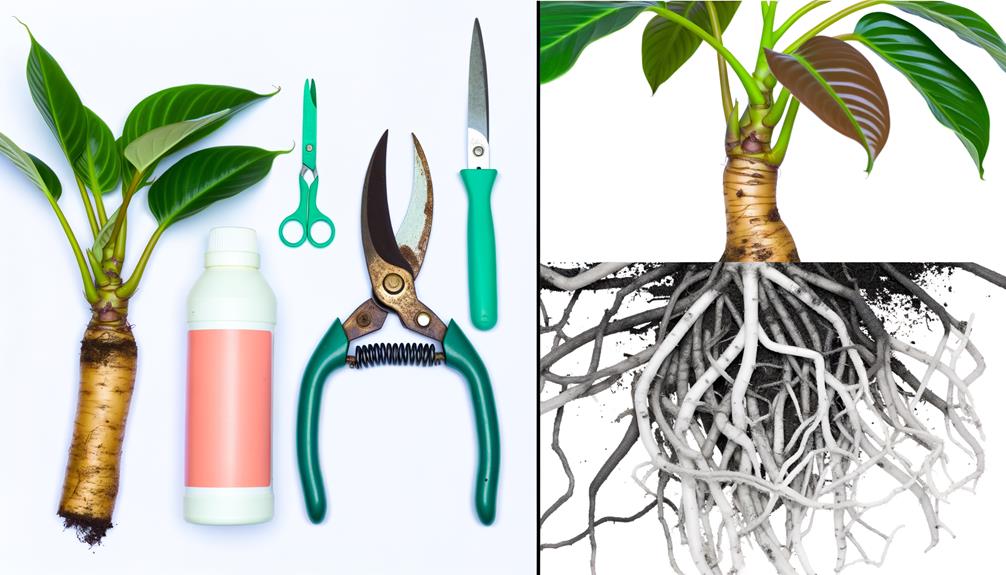
The prevalence of root rot and other diseases presents a significant challenge in maintaining the health and vigor of Philodendron Bipinnatifidum. To effectively manage these issues, it is crucial to understand their causes, symptoms, and appropriate treatment methods.
| Disease | Symptoms | Treatment |
|---|---|---|
| Root Rot | Yellowing leaves, wilting, root discoloration | Improve drainage, reduce watering, use fungicides |
| Leaf Spot | Brown or black spots on leaves | Remove affected leaves, apply fungicides |
| Bacterial Blight | Wilting, leaf spots, leaf drop | Eliminate infected plants, use bacterial-resistant varieties |
| Fusarium Wilt | Yellowing and wilting leaves | Use disease-free planting material, apply soil fungicides |
| Anthracnose | Leaf spots, leaf drop, dieback | Prune out infected areas, apply protective fungicides |
With careful observation and proactive management, one can mitigate these diseases, ensuring the continued growth and importance of the Philodendron Bipinnatifidum.
Repotting a Philodendron Bipinnatifidum
Undertaking the task of repotting a Philodendron Bipinnatifidum requires precise timing, meticulous preparation, and a thorough understanding of the plant’s root system.
This plant species prefers to be slightly root-bound, and it is generally recommended to repot every 2-3 years, ideally during the spring or summer.
The pot size should only be increased by one size to avoid waterlogging and root rot. A potting mix with excellent drainage is essential to prevent water accumulation around the roots.
During the repotting process, one must examine the root ball meticulously for signs of disease or damage. Any damaged or rotten roots should be pruned with a sterilized tool to prevent spreading of disease.
Careful handling of the roots during repotting will secure the future health and growth of the plant.
Incorporating Root Care Into Routine Maintenance
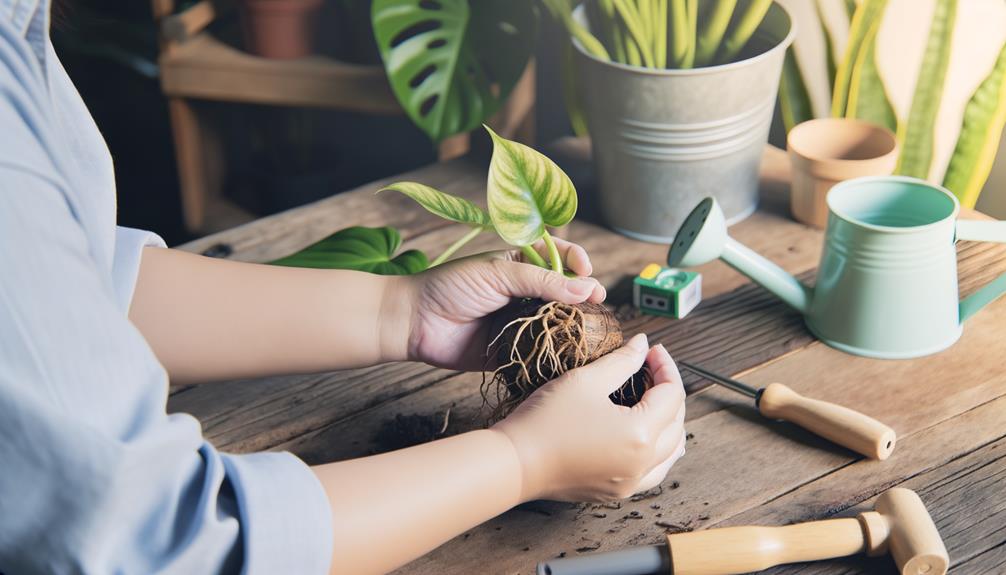
Beyond the repotting stage, continuous attention to the Philodendron Bipinnatifidum’s roots plays a pivotal role in the plant’s overall well-being, necessitating incorporation of root care into routine maintenance. This involves a two-pronged approach: regular monitoring and timely intervention.
| Routine Care Activity | Impact on Root Health |
|---|---|
| Regular inspection for root rot | Early detection allows for prompt treatment, preventing further damage |
| Ensuring proper watering routine | Prevents waterlogging and consequent root diseases |
| Application of necessary nutrients | Promotes healthy root growth and development |
Philodendron Bipinnatifidum Aerial Roots
Philodendron bipinnatifidum, also known as the Tree Philodendron or Split-Leaf Philodendron, is known for its large, deeply lobed leaves and its ability to produce aerial roots.
Here’s what you need to know about its aerial roots:
- Function: In its native habitat, Philodendron bipinnatifidum uses aerial roots to climb up trees and anchor itself for support. As a hemiepiphyte, it starts life on the ground but later grows up trees using these roots.
- Appearance: The aerial roots are stringy and fibrous, making them difficult to cut through with a saw due to the fibers getting caught in the blade.
- Indoor Growth: When grown as a houseplant, Philodendron bipinnatifidum will still produce aerial roots. These roots can help the plant climb a trellis or moss pole, or they can be placed in the soil to help support the plant.
- Pruning: If you don’t like the appearance of the aerial roots, they can be pruned off close to the main stem with sharp pruners. Removing aerial roots will not harm the plant.
- Propagation: Older Philodendron bipinnatifidum plants with woody stems and aerial roots can be propagated by division. Carefully remove the plant from its pot and divide it, making sure each division has roots and leaves.
So in summary, the aerial roots of Philodendron bipinnatifidum are a natural part of the plant’s growth habit, helping it climb and support itself. When grown indoors, you can choose to let the aerial roots grow, train them to climb a support, or prune them off if you prefer.
Conclusion
Essentially, the prosperity of Philodendron Bipinnatifidum is rooted in meticulous care, symbolizing a patient gardener’s dedication. Understanding root health, selecting suitable pots and soil, managing diseases, and incorporating root care into routine maintenance are crucial.
By following these guidelines, one can cultivate a thriving Philodendron Bipinnatifidum, embodying the symbiosis of nature’s resilience and human nurturing.

